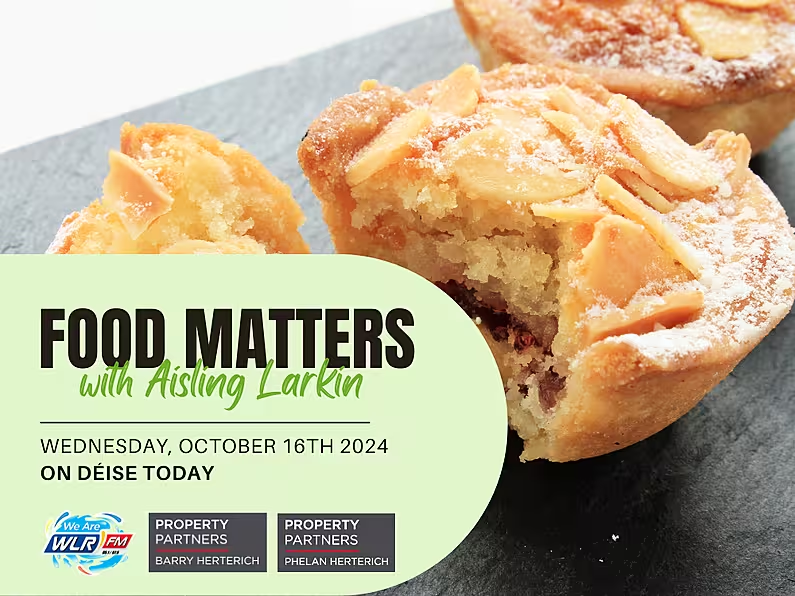In Episode 11 of Food Matters well-renowned Chef, TV Cook, and Food Media Broadcaster Aisling Larkin chats about Elderflower and Elderberries.
Food Matters is brought to you with thanks from Property Partners Barry Herterich and Property Partners Phelan Herterich who have offices in Tramore and Waterford City. With over 40 years combined experience both Barry and Deirdre bring a wealth of knowledge and experience in residential and commercial property, and we pride ourselves on our exceptional service, results-driven dedication, and our reputation for trustworthy, focused commitment to every client. With an emphasis on communication and integrity, we deliver expertise and success to all of our clients, presenting a bespoke service that always goes the extra mile.
Waterford City - Property Partners Phelan Herterich website HERE / Call 051-364052 / Connect on Facebook HERE
Tramore - Property Partners Barry Herterich website HERE / Call 051-330465 / Connect On Facebook HERE
Elderflower and Elderberries
So depending on the weather summer elderflower season kicks of around mid June and lasts for just a few weeks. The elder tree becomes covered in creamy-white umbels of flowers that are highly aromatic. The smell of elderflowers is like a summer's day, full of light floral and citrus notes. Some people describe it as almost like a grapefruit in scent but I think it has a note of apple blossom as well.
The flowers or blossoms cover the tree like white plates and their heady fragrance drenches the warm evenings as you walk past in the lanes in the long late sunlight of high summer. …
After the mid-summer season of elderflowers, each flower then turns in to an elderberry. Elderberries are rich and more fulsome, with a deep purple colour and once you start to cook them there is a strength to the flavour which can be almost eye-watering. Elderflowers are delicate and floral with the citrus notes present but not overpowering. Sweet and light, compared to the sharp and tangy tartness of elderberries. Elderflowers can only stand a small amount of heat.
Elderflowers are picked in early summer to infuse their aroma in refreshing drinks and some delicious recipes. The elderflower cordial has an incredibly delicate, subtle but lush flavour - there is the essence of elderflowers, each bursting with notes of pear, citrus, tropical fruit, and just a hint of honeysuckle.
Harvesting Tips – Elderflowers & Elderberries
- Harvest during a fleeting 3-4 weeks of mid summer.
- Avoid foraging elderflowers where there may be pollution from cars or traffic. It will really not be ideal to eat any plant that has been subjected to that!
- Do not over forage – leave enough for nature. Elderflowers turn into elderberries as well, as long as they have not all been foraged first!
- The smell varies with exposure to direct sunlight: in open sun, it is attractively lemony, but in shade can be unpleasantly musky. Sniff before you pick! And don’t pick the flowers in wet weather.
- Collect elderflowers first thing in the morning before the sun has had a chance to draw all of the nectar away. Cut with a scissors. Don’t pull them.
- Avoid flowers that have been wilted or starting to turn brown. Elderflowers are best just as they are opening up.
- Turn the elderflowers upside down and gently shake loose any wildlife that may be living on it. Do this before you even take home to wash as then you can make sure to not carry the bugs into your kitchen.
- Avoid gathering any leaves or bark from the elder tree as they are toxic and should be avoided.
- Smell your elderflowers and if they have a slightly wee like aroma then do not pick them. This is a sign that they are starting to go over.
- From the moment the flowers are picked it’s a race against time to capture the natural freshness of the elderflowers. The elderflowers are handpicked usually early in the morning, when temperature is cooler. This ensures the flowers are just opening and the aroma and flavour of the blossoms are at their peak. The process is a labor of love and delicate precision
- With elderberries gather them when the fruit is dark but not puckered and not squishy to the touch.
- Do not be tempted to try as you pick! Make sure to get this message across to any children helping you out as well. Raw elderberries and even elderflowers are toxic. But it is seriously something to keep reminding yourself as I do a lot of eating as I pick normally!
Culinary Uses & Medicinal Purposes
Medicinal Properties of Elder:
Elder has a long history of medicinal use and it’s still much used by herbalists. Elderflower has a number of medicinal properties, such as expectorant, anticatarrhal, circulatory stimulant, antiviral and anti-inflammatory. Furthermore, an infusion of elderflowers can also be drunk to relieve hay fever or stress.
In our times the bark and root are considered rather too purgative for everyday use, but the flowers taken as a tea encourage sweating and help break a fever. The flowers, as a tea, can also cut congestion and relieve respiratory infections and hay fever. Elderberries have high vitamin C content and are quite effective for treating winter colds and flu.
Since Covid blackcurrant and elderberry have become two really popular pharmaceutical-based tonics and syrups to help with immunities in terms of cold and cases of flu. Elderberries are packed with nutrients and are basically the more mature version of the flowers. Elderberry is used to help boost your immune system.
Culinary Uses;
Ok so by now we have established that both the flowers and ripe berries are edible.
Elderflower is typically infused fresh for herbal tea, cordial and other drinks, such as flavoured liqueurs and sparkling wine or “elderflower champagne”.
Unripe berries are preserved in vinegar and used as “elderberry capers”.
Elderberries are cooked into tonics, jams, jellies and syrups, though they are also used to make country wine and vinegar.
Beverages from elderberries and elderflowers have been produced for centuries.
How to Make Elderflower Cordial
Dissolve the sugar in the water in a large saucepan, and start gently heating it on low heat; don’t let it come to a boil or caramelise. Keep stirring until you are absolutely sure that there are no crystals anywhere in the syrup.
Place the unwashed elderflower (if you wash them, you lose the pollen) heads in a pre-sterilised fermenting tub, layered with the chopped lemons.
Let the sugar syrup cool to room temperature and then mix in the citric acid and the lemon juice. Pour this over the flowers, cover it and let it sit in a cool place for about 1 or 2 days, giving it a stir every now and then with a sterilised spoon.
Sterilise a big pot, a sieve and a muslin cloth along with a ladle and all of the bottles you’ll be filling up.
Fix the sieve over the pot and place the muslin inside it. Spoon your syrup and flowers into the muslin and let the cordial collect in the pot.
After you’ve got all of your cordial, get a funnel (which should also be sterilised), and fill the bottles up to the top. Keep these bottles in a cool, dry place, and once a bottle is opened, keep in the fridge.
My Elderflower Cordial Recipe:
Ingredients
- 1 kg Granulated sugar
- 1 liter boiling water
- 50 g citric acid or juice 2 large lemons
- zest of 2 large lemons
- 15 elderflower heads, stalks removed elderflower heads, stalks removed
Directions
- Put the sugar in a bucket or basin with the boiling water and stir to dissolve. Add the citric acid or lemon juice and the lemon zest.
- Shake the elderflowers to remove any insects and add the flowers to the sugar syrup. Cover and leave to stand for 1-2 days, stirring morning and night.
- Strain the elderflower cordial through muslin and decant into sterilised bottles. It’s now ready to use.
- Add to water and ice for a refreshing, long drink or top up with Prosecco or Champagne for a summer fizz. Yum!
For past Food Matters episodes click HERE














